Critical Review of 'Addictive Potential of Binge Watching' Research
VerifiedAdded on 2022/09/12
|5
|1083
|20
Report
AI Summary
This report presents a critical review of a research article that investigates the addictive potential of binge-watching among young adults, comparing intentional and unintentional viewing habits. The study explores two hypotheses: the correlation between impulsivity and binge-watching frequency, and the mediating role of binge-watching in increasing addiction symptoms. The researchers define intentional binge-watching as planned viewing and unintentional binge-watching as unplanned prolonged viewing. The study, conducted on undergraduate students, utilized online questionnaires and the Barratt Impulsivity Scale to gather data. The findings suggest that impulsivity levels fluctuate, being less pronounced during the semester and increasing during breaks. The review highlights the study's strengths, such as collecting first-hand experiences, but also notes limitations like the lack of adult binge-watching data and measurement issues. The conclusion emphasizes the study's value in understanding the link between binge-watching, impulsivity, and the behavior of the new generation.
1 out of 5








![[object Object]](/_next/static/media/star-bottom.7253800d.svg)